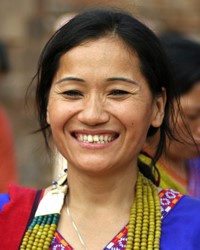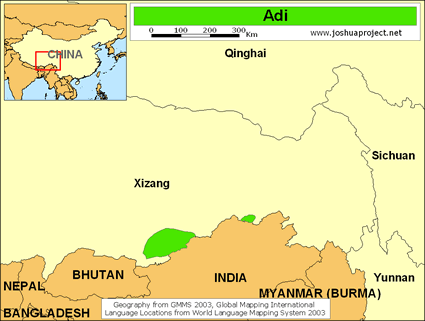The Adi do not appear in Chinese government publications. It is likely that they have been officially counted as part of the Lhoba nationality, who have a similar language and live in the same region. In India, Adi is a general name given for a collection of as many as 15 tribes or subgroups, including the Ramo, Bokar, Bori, and Shimong.
The Adi language is part of the Baric branch of the Tibeto-Burman family. Most sources list Adi and Miri as two dialects of the same language, while other scholars describe them as two distinct, mutually unintelligible languages.
After the communist takeover of Tibet in the 1950s, the Indian military went on full alert. In the following decades, several border skirmishes between the two giant nations took place, particularly at the opposite ends of the Himalayan Range. Those Adi who are now located in China did not migrate there but found themselves technically in Tibet as the result of the redrawing of international boundaries after these conflicts. The Adi are perhaps the most remote people in China.
Expression by dance is an important part of the Adi culture. Religious and war dances use aggressive movements to relate the violent history of the Adi against other tribes in northeast India. Adi women are renowned throughout northern India as expert weavers.
The Adi in Tibet are an isolated people who follow an ancient form of shamanism. Acting as mediums between the Adi and the spirit world, shamans often fall into demonic trances while communicating with the spirits. In India, some Adi have converted to Hinduism. Some Adi in Tibet outwardly adhere to Tibetan Buddhism more to please their aggressive Tibetan neighbors than from sincere, heartfelt conviction.
There are reports of existing churches among the Adi in India, largely due to the work of the Baptist General Conference. Locked in by massive mountains, few Adi in China have ever heard the gospel. Adi territory is rugged and off-limits to foreigners: It is inaccessible from the Chinese side. The Adi in both India and China remain an unreached people in desperate need of attention from the global Body of Christ. The conversion of the Adi would likely impact dozens of smaller, related peoples throughout this ethnically diverse area.
The Adi need to hear about God's love and salvation from sin. They need God to move the hearts of loving workers to go to them.
Pray for the Lord to rally prayer warriors who will plow spiritual ground for the Adi people
Pray that the Adi people will be pressed by dreams of the loving man in white: Jesus! Ask him to give them visions that will testify to his kingdom.
Pray that as they seek Christ, miracles will testify of his faithfulness.
Pray for workers who are driven by love and boldness of the Holy Spirit to go to them.
Pray for a movement to Christ among them to begin even before workers can physically reach them!
Scripture Prayers for the Adi in China.
Operation China, Asia Harvest, Copyrighted © Used with permission.
| Profile Source: Joshua Project |













